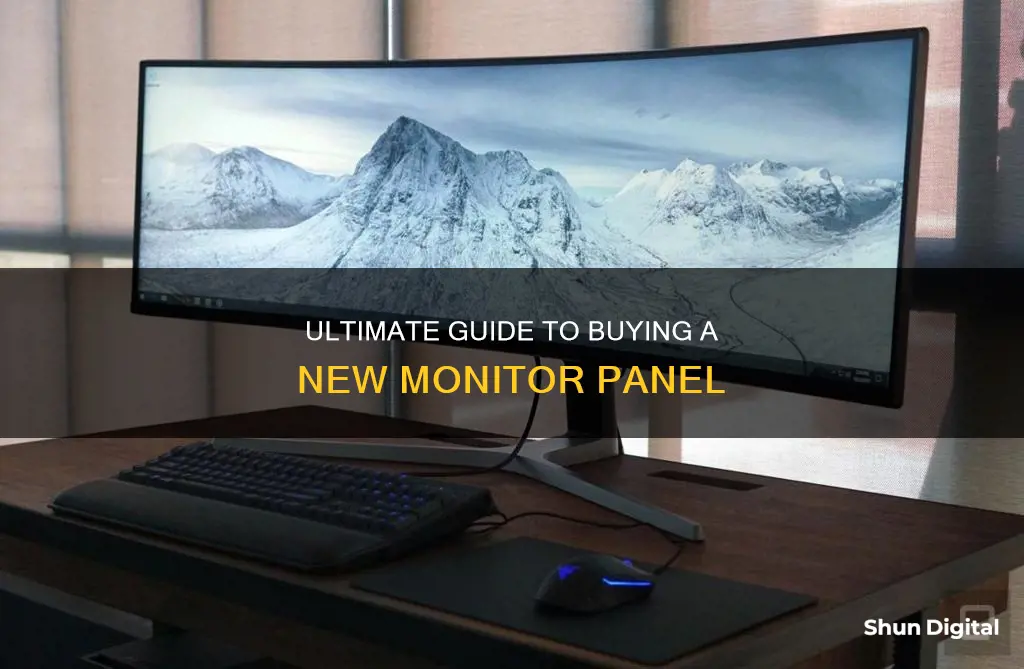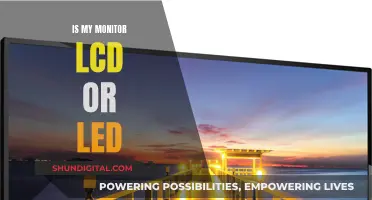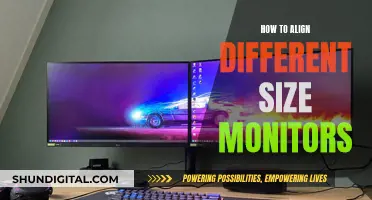
If you're looking to buy a new monitor panel, there are a few things you need to keep in mind. First, determine the type of panel you want – options include TN, IPS, VA, and OLED, each with its own advantages and disadvantages. For example, while IPS panels offer good sharpness and viewing angles, VA panels have better contrast ratios and darker black levels. Next, consider the size of the panel – a 27-inch monitor is a popular choice, but you can go bigger or smaller depending on your preferences and how much desk space you have. Additionally, think about the resolution you need – 1440p is recommended, but 4K is a nice upgrade if your budget allows. Other factors to consider include the refresh rate, adaptive sync, ergonomics, and extra features such as USB-C connectivity. When shopping for a new monitor panel, compare prices across different retailers, as sales and availability can cause significant price variations.
| Characteristics | Values |
|---|---|
| Monitor type | TN, IPS, VA, OLED |
| Monitor size | 24-inch, 27-inch, 32-inch widescreen |
| Monitor resolution | 1080p, 1440p, 4K |
| Monitor refresh rate | 60Hz, 144Hz, 240Hz, 360Hz, 500Hz |
| Monitor adaptive sync | AMD FreeSync, Nvidia G-Sync, VESA AdaptiveSync |
| Monitor stand | Height and tilt adjustment, swivel, pivot, VESA mount support |
| Monitor HDR | Mini-LED, OLED |
| Monitor features | USB-C, speakers, remote control |
What You'll Learn

Monitor types: TN, IPS, VA, and OLED panels
There are several types of monitor panels available, each with its own advantages and disadvantages. Here's a breakdown of the four main types:
Twisted Nematic (TN) panels:
TN panels are known for their fast response times and high refresh rates, making them a popular choice for gaming monitors. They are typically the most affordable option and are suitable for competitive multiplayer gaming where every split second matters. However, TN panels often have poor colour reproduction and limited viewing angles, which can cause colour shift and image fade when viewed from wide angles.
In-Plane Switching (IPS) panels:
IPS panels are known for their excellent colour reproduction and wide viewing angles, making them ideal for media viewing and colour-critical work such as graphic design. They are also a good choice for local multiplayer gaming due to their wide viewing angles. However, IPS panels tend to have lower contrast ratios and poorer black levels compared to other types, which can make dark images appear hazy.
Vertical Alignment (VA) panels:
VA panels offer a good balance between colour reproduction, viewing angles, and contrast ratios. They have improved colour accuracy and viewing angles compared to TN panels and are commonly used in TVs. VA panels are a great option for gaming, especially for those who play a variety of genres and want good all-round performance. However, they may not be the best choice for competitive gaming as they have slightly slower response times than TN panels.
Organic Light-Emitting Diode (OLED) panels:
OLED panels offer the best image quality with perfect black levels, excellent colour accuracy, and wide viewing angles. They also have the fastest response times, even faster than TN panels. However, OLED panels are more expensive and susceptible to image retention and burn-in issues.
In summary, each panel type has its strengths and weaknesses, and the best choice depends on your specific needs and budget. TN panels are ideal for competitive gaming, IPS panels offer the best colour accuracy and viewing angles, VA panels are a good all-round choice, and OLED panels provide the best image quality but come with a higher price tag.
Setting Up the ProArt 248Q: A Step-by-Step Guide
You may want to see also

Monitor size: 24-inch, 27-inch, or 32-inch widescreen
When buying a new monitor, it's important to consider the size that best suits your needs. The most popular sizes available are 24-inch, 27-inch, and 32-inch widescreen panels. Here's a detailed guide to help you decide between these options:
24-inch Monitors
24-inch monitors are typically ideal for casual users. They are more affordable and don't take up too much desk space. In terms of resolution, a 24-inch monitor usually works best with a 1920 x 1080 resolution (Full HD). While you can use higher resolutions, some software, programs, and games may not scale well to this smaller screen size. Additionally, the text and icons displayed on a 24-inch monitor are generally large enough, making it comfortable for browsing and everyday use without needing to adjust text scaling.
27-inch Monitors
27-inch monitors offer a balance between size and functionality. They provide more screen real estate than a 24-inch monitor, making them ideal for more serious uses, such as photo editing, programming, or gaming. In terms of resolution, a 27-inch monitor is well-suited for 1440p or even 4K resolution. The text displayed on a 27-inch monitor may appear smaller, and you may need to adjust the text scaling within your operating system for comfort.
32-inch Monitors
32-inch monitors are ideal for professional editing and gaming, where a large display, high resolution, and excellent picture quality are required. They offer ample screen space, making them perfect for tasks like video editing, where you need multiple windows open simultaneously. However, keep in mind that you'll likely need to sit at a comfortable distance from the monitor, and text scaling may be necessary to avoid straining your eyes.
Final Thoughts
The best size depends on your specific requirements. If you're a casual user or have limited desk space, a 24-inch monitor could be a perfect choice. On the other hand, if you're a gamer or a professional user who needs the extra screen real estate, a 27-inch or 32-inch monitor would be more suitable.
Understanding Monitor Types: LED, LCD, and Plasma Differences
You may want to see also

Monitor resolution: 1080p, 1440p, or 4K
When it comes to monitor resolution, there are a few common options to choose from: 1080p, 1440p, and 4K. So, which one is right for you? Well, it depends on a few factors.
First, let's talk about the differences between these resolutions. 1080p monitors have a resolution of 1920 x 1080, which is often considered the minimum for a decent viewing experience. 1440p monitors bump up the resolution to 2560 x 1440, which provides a noticeable increase in sharpness, especially for larger displays. 4K monitors have an even higher resolution of 3840 x 2160, delivering exceptionally sharp and detailed images.
Now, let's discuss how these resolutions affect your viewing experience. If you're mainly using your monitor for gaming or simple productivity tasks, a 1080p monitor can be a great budget-friendly option. It can achieve high refresh rates and doesn't require high-end hardware to run games. However, 1080p monitors may struggle with displaying higher-resolution media content correctly. If you're looking for a balance between performance and visuals, 1440p monitors are often considered the "sweet spot." They offer significantly crisper visuals and more screen space, making them versatile for both work and play. Keep in mind that 1440p monitors require a more powerful graphics card than 1080p screens. If you want the sharpest image and text clarity, 4K monitors are the way to go. They provide an immersive experience, especially for high-resolution media content and extensive graphic work. However, 4K monitors also come with a higher price tag and require a powerful graphics card, especially for gaming.
It's worth noting that the ideal resolution also depends on the size of the monitor. For a 24-inch monitor, 1080p resolution is generally sufficient. Moving up to a 27-inch or 32-inch monitor, 1440p resolution is recommended to maintain a sharp image. If you're going for an even larger display, 4K resolution becomes more appealing to ensure a crisp viewing experience.
In summary, when choosing between 1080p, 1440p, and 4K monitor resolutions, consider your intended use, budget, and the size of the monitor. 1080p is great for budget-minded users and basic tasks, 1440p offers a versatile balance between performance and visuals, and 4K delivers the best image quality for high-resolution media and graphic work but comes with a higher cost and hardware requirements.
Choosing the Right Monitor Size for Competitive CS:GO
You may want to see also

Monitor refresh rate: 60Hz, 144Hz, 240Hz, or 360Hz
A monitor's refresh rate refers to the number of times the monitor's display is updated per second. Higher refresh rates offer a smoother and more fluid viewing experience.
Most monitors have a 60Hz refresh rate, which is suitable for everyday tasks like office work, browsing the web, and slower-paced games. However, for fast-paced gaming or watching action movies, a higher refresh rate is preferable.
A 144Hz refresh rate is a significant upgrade for gamers, offering a smoother and more responsive experience. Monitors with a 240Hz refresh rate and beyond are even smoother but are more of an optional luxury. These higher refresh rates are ideal for competitive gaming, providing reduced input lag and a faster response time, which can directly enhance performance in fast-paced games.
If you're a casual gamer or primarily use your monitor for everyday tasks, a 120Hz, 144Hz, or 165Hz monitor should be sufficient. For those who emphasise resolution and colour accuracy, a 60Hz or 75Hz monitor will suffice.
It's worth noting that to take full advantage of a high refresh rate monitor, you'll need a capable graphics card and CPU to match. Additionally, ensure your PC can handle the upgrade, as higher refresh rates may require more powerful hardware.
Monitoring Memory Usage in Embedded Linux: Practical Tips
You may want to see also

Monitor features: speakers, remote control, or USB-C
When it comes to monitor features, there are a few key things to look out for, such as speakers, remote control functionality, and USB-C compatibility.
Speakers
Built-in speakers are a convenient feature for monitors, eliminating the need for external speakers. While some monitors do have speakers, the quality can vary, and they may not always be the best option for audio. If you're an audiophile or simply want better sound quality, you may want to consider investing in a separate set of computer speakers.
Remote Control
A remote control can be a handy addition to your monitor, allowing you to adjust settings and control your display from the comfort of your couch or desk. However, not all monitors come with this feature, so if remote control is a must-have for you, be sure to look for it specifically.
USB-C
USB-C is a versatile connection option for monitors. It allows you to connect devices like laptops directly to your monitor using a single cable. Additionally, USB-C ports can often deliver power to your devices, charging them while they're connected. This is especially useful if you're looking to reduce cable clutter and streamline your setup.
When choosing a monitor with USB-C, consider the power delivery capabilities, as some ports may not provide enough power to charge your laptop while it's in use. Additionally, look for monitors that support DisplayPort Alt Mode, which allows for both video and data transfer over a single connection.
Some USB-C monitors also offer a KVM (Keyboard, Video, Mouse) switch, which lets you automatically switch your peripherals between different computers connected to the monitor. This can be extremely useful if you're working with multiple devices.
USB-C hubs are another feature to look out for. These hubs provide additional USB-A or USB-C ports, allowing you to connect multiple devices to your monitor and create a centralized hub for your setup.
In summary, when buying a new monitor, consider your specific needs and budget. Decide which features, such as speakers, remote control, or USB-C functionality, are most important to you, and don't forget to read reviews and compare different models to find the best option for your setup.
Differentiating Speakers and Monitors: A Quick Guide
You may want to see also
Frequently asked questions
The four main types of monitor panels are TN (Twisted Nematic), IPS (In-Plane Switching), VA (Vertical Alignment), and OLED (Organic Light-Emitting Diode). Each has its pros and cons in terms of colour performance, viewing angles, contrast, and black levels.
Monitor size is a personal preference. A 24-inch monitor is standard, but you can go bigger if you prefer. Just ensure the display fits within your field of view to avoid eye strain or the need for head movement.
The ideal resolution depends on the monitor size. For a 24-inch monitor, 1080p is standard, while a 27-inch or larger monitor should have a resolution of 1440p or 4K for sharper images and better gaming and movie experiences.
You can purchase monitor panels from online retailers like Amazon, Newegg, and eBay. However, larger panels may be harder to find and may require bulk purchases.







